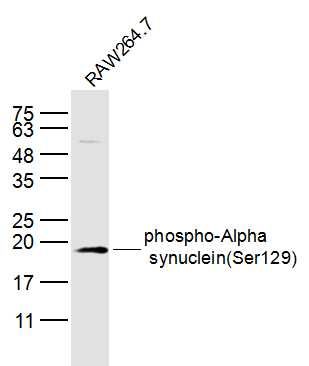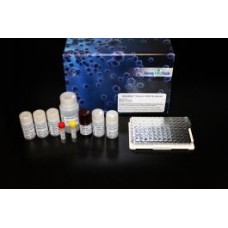alpha Synuclein antibody
GTX112799
ApplicationsImmunoFluorescence, Western Blot, ImmunoCytoChemistry, ImmunoHistoChemistry, ImmunoHistoChemistry Frozen, ImmunoHistoChemistry Paraffin
Product group Antibodies
TargetSNCA
Overview
- SupplierGeneTex
- Product Namealpha Synuclein antibody
- Delivery Days Customer9
- Application Supplier NoteWB: 1:500-1:3000. ICC/IF: 1:100-1:1000. IHC-P: 1:100-1:1000. IHC-Fr: 1:100-1:1000. *Optimal dilutions/concentrations should be determined by the researcher.Not tested in other applications.
- ApplicationsImmunoFluorescence, Western Blot, ImmunoCytoChemistry, ImmunoHistoChemistry, ImmunoHistoChemistry Frozen, ImmunoHistoChemistry Paraffin
- CertificationResearch Use Only
- ClonalityPolyclonal
- Concentration1.15 mg/ml
- ConjugateUnconjugated
- Gene ID6622
- Target nameSNCA
- Target descriptionsynuclein alpha
- Target synonymsNACP, PARK1, PARK4, PD1, alpha-synuclein, I+/--synuclein, non A-beta component of AD amyloid, synuclein alpha-140, synuclein, alpha (non A4 component of amyloid precursor)
- HostRabbit
- IsotypeIgG
- Protein IDP37840
- Protein NameAlpha-synuclein
- Scientific DescriptionAlpha-synuclein is a member of the synuclein family, which also includes beta- and gamma-synuclein. Synucleins are abundantly expressed in the brain and alpha- and beta-synuclein inhibit phospholipase D2 selectively. SNCA may serve to integrate presynaptic signaling and membrane trafficking. Defects in SNCA have been implicated in the pathogenesis of Parkinson disease. SNCA peptides are a major component of amyloid plaques in the brains of patients with Alzheimers disease. Four alternatively spliced transcripts encoding two different isoforms have been identified for this gene. [provided by RefSeq]
- Storage Instruction-20°C or -80°C,2°C to 8°C
- UNSPSC12352203
References
- Kim W, Tripathi M, Kim C, et al. An optimized Nurr1 agonist provides disease-modifying effects in Parkinson's disease models. Nat Commun. 2023,14(1):4283. doi: 10.1038/s41467-023-39970-9Read this paper
- Yin S, Han C, Xia Y, et al. Cancerous Inhibitor of Protein Phosphatase 2A (CIP2A): Could It Be a Promising Biomarker and Therapeutic Target in Parkinson's Disease? Mol Neurobiol. 2022,59(2):1333-1344. doi: 10.1007/s12035-021-02670-wRead this paper
- Park SJ, Jin U, Park SM. Interaction between coxsackievirus B3 infection and α-synuclein in models of Parkinson's disease. PLoS Pathog. 2021,17(10):e1010018. doi: 10.1371/journal.ppat.1010018Read this paper
- Chen HY, Hsu CL, Lin HY, et al. Clinical and functional characterization of a novel STUB1 frameshift mutation in autosomal dominant spinocerebellar ataxia type 48 (SCA48). J Biomed Sci. 2021,28(1):65. doi: 10.1186/s12929-021-00763-1Read this paper
- Akiyama T, Sato S, Ko SBH, et al. Synthetic mRNA-based differentiation method enables early detection of Parkinson's phenotypes in neurons derived from Gaucher disease-induced pluripotent stem cells. Stem Cells Transl Med. 2021,10(4):572-581. doi: 10.1002/sctm.20-0302Read this paper
- Kwon Y, Bang Y, Moon SH, et al. Amitriptyline interferes with autophagy-mediated clearance of protein aggregates via inhibiting autophagosome maturation in neuronal cells. Cell Death Dis. 2020,11(10):874. doi: 10.1038/s41419-020-03085-6Read this paper
- Zeng H, Yu BF, Liu N, et al. Transcriptomic analysis of α-synuclein knockdown after T3 spinal cord injury in rats. BMC Genomics. 2019,20(1):851. doi: 10.1186/s12864-019-6244-6Read this paper
- Han C, Xiong N, Guo X, et al. Exosomes from patients with Parkinson's disease are pathological in mice. J Mol Med (Berl). 2019,97(9):1329-1344. doi: 10.1007/s00109-019-01810-zRead this paper
- Lee S, Oh ST, Jeong HJ, et al. MPTP-induced vulnerability of dopamine neurons in A53T α-synuclein overexpressed mice with the potential involvement of DJ-1 downregulation. Korean J Physiol Pharmacol. 2017,21(6):625-632. doi: 10.4196/kjpp.2017.21.6.625Read this paper
- Bastías-Candia S, Di Benedetto M, D'Addario C, et al. Combined exposure to agriculture pesticides, paraquat and maneb, induces alterations in the N/OFQ-NOPr and PDYN/KOPr systems in rats: Relevance to sporadic Parkinson's disease. Environ Toxicol. 2015,30(6):656-63. doi: 10.1002/tox.21943Read this paper







![IHC-P analysis of human brain, Lewy body dementia using GTX01946 alpha Synuclein antibody [KM51]. Note staining of alpha-synuclein-containing Lewy bodies.](https://www.genetex.com/upload/website/prouct_img/normal/GTX01946/GTX01946_20200811_IHC-P_92_w_23053121_721.webp)